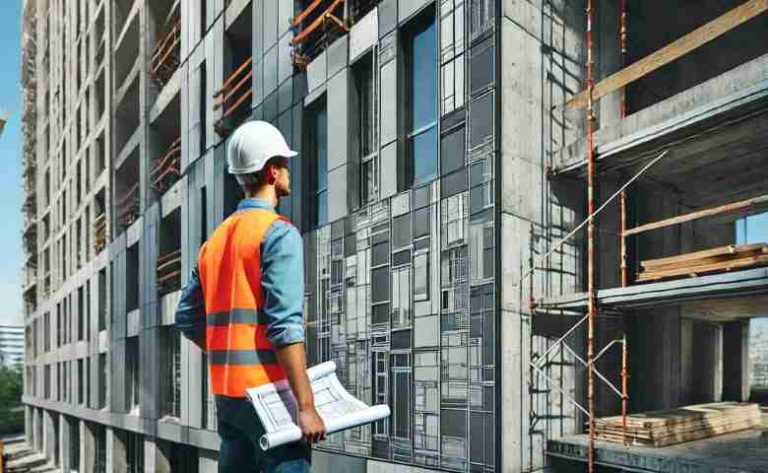In the ever-evolving landscape of modern construction, the role of facade engineers is becoming increasingly significant. As the industry advances with innovative materials and designs, the necessity for specialised knowledge in facade engineering is paramount to creating structures that are not only aesthetically pleasing but also functionally robust and environmentally sustainable. This article aims to delve into the pivotal role played by expert facade engineers, and explain how they contribute to the modern construction sector.
Table of Contents
Understanding Facade Engineering
Facade engineering is a specialised discipline that focuses on the design, construction, and maintenance of building exteriors – known as facades. The job of a facade engineer is multifaceted, encompassing aesthetics, energy efficiency, durability, and building functionality. A facade is more than just the ‘face’ of the building; it plays a crucial role in how a building performs in its environment.
The Aesthetic Aspect
The architectural appearance of a building’s facade is crucial. It’s the first thing people notice and defines the identity and character of a construction. Expert facade engineers work closely with architects to realise their vision while ensuring the pragmatic aspects of the facade are addressed adequately. They must balance creativity with practicality, ensuring the facade design is both visually compelling and technically viable.
The Functional Role
Beyond their aesthetic value, facades play a significant functional role. They act as the barrier between the internal and external environments, influencing the indoor climate, acoustics, and lighting conditions. Expert facade engineers ensure that the building’s skin performs efficiently, controlling the movement of heat, air, and moisture. This involves understanding and applying principles of thermodynamics, material science, and fluid mechanics.
Energy Efficiency and Sustainability
One of the paramount considerations in today’s construction practices is sustainability. Facade engineers are at the forefront of designing building envelopes that minimise energy consumption. By selecting the right materials and incorporating sustainable technologies, they make buildings more energy-efficient and decrease operational costs. High-performance facades designed by these engineers are key to reducing a building’s carbon footprint.
The Facade Design and Planning Process
The intricate process of facade design and planning is a collaborative effort that requires a deep understanding of architectural principles, engineering mechanics, material properties, and building regulations. During the design phase, facade engineers work with the design team to develop a system that aligns with the overall aesthetic intentions and complies with all structural requirements.
In planning the facade, attention to detail is essential. Facade engineers utilise advanced modelling software to simulate how the facade will perform under various conditions. This might include stress tests, thermal modelling, and acoustics simulations, ensuring the facade can withstand environmental pressures such as wind load, temperature variations, and sound pollution.
Moreover, facade engineers are responsible for navigating the complex interplay of regulations and standards. They must ensure that the design adheres to local codes pertaining to energy efficiency, safety, and longevity. They also stay abreast of advancements in construction methods and materials to push the boundaries of what is achievable with facade systems.
Maintenance and Renovation
Facades, like any other part of a building, can deteriorate over time and may require attention to maintain their performance and appearance. Facade engineers are instrumental in assessing existing building facades to identify any structural or aesthetic issues that may need addressing.
Maintenance strategies developed by facade engineers ensure that the building continues to perform as intended and remains safe for occupants and the public. They might recommend proactive measures such as cleaning protocols, protective coatings, or structural reinforcements to extend a facade’s lifespan.
In cases where the facade has degraded significantly, engineers specialising in this field will design strategies for renovation or replacement. This includes projects focused on remedial window and door repairs, where attention to detail and an understanding of historical construction techniques may be necessary. Engineers bring old facades up to modern standards while preserving the unique characteristics that define a building’s historical value.
The Future of Facade Engineering
The future of facade engineering holds promise for even more innovative and sustainable building envelopes. As the world becomes more digital and technology-driven, facade engineers will likely work with smart facade systems that adapt to environmental changes in real time, optimising energy use and enhancing indoor comfort without human intervention.
Material advancements will also continue to be a critical area for facade engineers. The exploration of new composites, smart glasses, and living facades incorporating vegetation are just a few examples of where the industry is headed. These new materials and technologies will allow buildings to not only consume less energy but also actively produce energy, further reducing their environmental impact.
Conclusion
Facade engineers are a pivotal part of the modern construction industry. Their role bridges the gap between aesthetic aspirations and engineering realities, creating buildings that are visually stunning, long-lasting, and environmentally conscious. As construction continues to evolve, the demand for expert facade engineers who can push the boundaries and deliver solutions that meet the sophisticated needs of contemporary building practices will only increase.
In summary, the impact of expert facade engineers, their expertise in facade design and planning, and their problem-solving skills in remedial window and door repairs are indispensable elements in shaping the sustainable and resilient built environments of the future. Their work ensures that our cities and structures resonate not only with today’s standards but are also prepared for tomorrow’s challenges.
